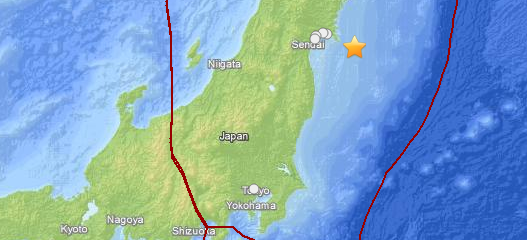Strong earthquake M 6.0 struck near crippled Fukushima Dai-ichi plant

A strong earthquake registered as M 6.0 (JMA) on Richter scale struck northeastern Japan on August 4, 2013 at 03:28 UTC. JMA reported depth of 50 km. This earthquake was 41 km away from March 11, 2011 devastating M 9.0 "Tohoku earthquake" and about 109 km away from crippled Fukushima nuclear power plant.
There was no risk of a tsunami, JMA said.
Operator of crippled nuclear power plant Fukushima Dai-ichi said no problems were reported there or at another one of its nuclear plants in Fukushima..
USGS measured magnitude 5.8 earthquake and depth of 46 km.
Fukushima-Diary reported yesterday that unusual number of the earthquakes are occurring in the region. 18 quakes hit Fukushima and also 18 quakes hit Iwaraki only within a day.
Following a major earthquake on March 11, 2011, a 15-meter tsunami disabled the power supply and cooling of three Fukushima Dai-ichi reactors (Unit 1-3). All three cores largely melted in the first three days. Unit 4 became a problem in next 5 days.

Tectonic summary by USGS
Seismotectonics of Japan and Vicinity
Japan and the surrounding islands straddle four major tectonic plates: Pacific plate; North America plate; Eurasia plate; and Philippine Sea plate. The Pacific plate is subducted into the mantle, beneath Hokkaido and northern Honshu, along the eastern margin of the Okhotsk microplate, a proposed subdivision of the North America plate. Farther south, the Pacific plate is subducted beneath volcanic islands along the eastern margin of the Philippine Sea plate. This 2,200 km-long zone of subduction of the Pacific plate is responsible for the creation of the deep offshore Ogasawara and Japan trenches as well as parallel chains of islands and volcanoes, typical of Circumpacific island arcs. Similarly, the Philippine Sea plate is itself subducting under the Eurasia plate along a zone, extending from Taiwan to southern Honshu that comprises the Ryukyu Islands and the Nansei-Shoto trench.
Subduction zones at the Japanese island arcs are geologically complex and produce numerous earthquakes from multiple sources. Deformation of the overriding plates generates shallow crustal earthquakes, whereas slip at the interface of the plates generates interplate earthquakes that extend from near the base of the trench to depths of 40 to 60 km. At greater depths, Japanese arc earthquakes occur within the subducting Pacific and Philippine Sea plates and can reach depths of nearly 700 km. Since 1900, three great earthquakes occurred off Japan and three north of Hokkaido. They are the M8.4 1933 Sanriku-oki earthquake, the M8.3 2003 Tokachi-oki earthquake, the M9.0 2011 Tohoku earthquake, the M8.4 1958 Etorofu earthquake, the M8.5 1963 Kuril earthquake, and the M8.3 1994 Shikotan earthquake.
Featured image: USGS + Leaflet

I hope they hurry up and decide what there going to do with this power plant as the longer its left, the more radio active waste is ''accidentally'' leaked into open sea. This is a serious potentially internationally affecting matter that must be addressed soon before containment can no longer be effective. Expect some larger scale disaster story in the up and coming months folks as this is about to get very hairy. 🙁
After Japan's near M6 yesterday, I get an irking feeling that we may see some more substantial movements in the western Pacific regions in the near future. This quake was, as mentioned in the article, near the site of the M9 of 11/3/12. I am wondering if this is a movement related to a potential beginning of more to come. If we see M5's and M5+'s occurring in the short term in the islands NE of Australia, Indonesia, Kamchatka, Taiwan, near Davao, and towards NZ, this may be an indicator that the western side of the ROF is gearing up for a more substantial movement…just a thought. Corresponding movements may occur near Mexico/Gulf of California, Northern California/Canada offshore, Alaska and maybe even near Easter Island….this is just an amateur hypothesis.
Nothing good will come of this for sure